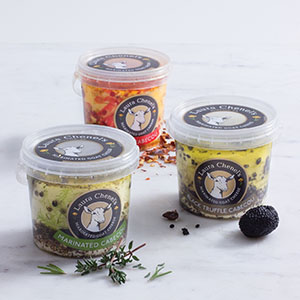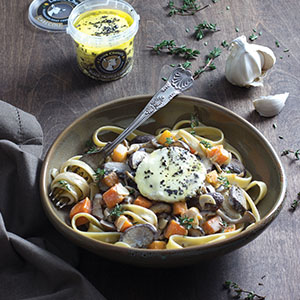Laura Chenel’s was founded by its namesake in 1979, though starting a cheese company was not her initial goal. As a young woman, Chenel was someone who traveled a great deal and was an early adaptor of the belief that one should provide their own food. She grew and made what she could, and acquired some goats, too, in the process.

She fell in love with her animals, but since she did not drink much goat milk, Chenel needed an outlet for it and decided to try her hand at making cheese.
“The story goes that she wasn’t very satisfied in the beginning with her cheesemaking efforts and ended up giving some of her milk to a local cheesemaker who, in turn, made Jack cheese, using the goat’s milk,” says Manon Servouse, who serves as brand manager for the company, which is based in Sonoma.
Still, curious as to what other cheeses she could make with her goats’ milk, and encouraged to explore French-style goat cheese after having sampled French chèvre, Chenel headed to France, as she found no one locally in California who could give her the guidance she was seeking.

“It was there that she learned French cheesemaking techniques — goat cheese specifically,” says Servouse. “After spending several months in France and learning the craft firsthand, Laura moved back to the United States and she started making goat cheese, mostly aged products.”
Once Chenel was content with the outcome of her trials, she set out looking for buyers. As fate would have it, she came across Alice Waters of renowned Chez Panisse in Berkeley.
“Alice ended up liking Laura’s cheese so much that she placed a standing order,” says Servouse. “On a regular basis, every week, Waters was ordering Laura Chenel’s goat cheese. It’s in large part thanks to Alice’s love of the chèvre and her own iconic California goat cheese salad that put Laura Chenel’s on the map. The goat cheese salad became a classic that is still on many menus across the United States today, and Laura is considered the pioneer in producing that very goat cheese for the American market.”
Over almost four decades, Laura Chenel’s has upheld a long tradition of European-style artisan cheesemaking using fresh American goat’s milk to produce the highest quality, handcrafted cheese, which has made it the standard for American chèvre today.

Growth Through The Years
In 1983, two years after the cheese’s debut at Chez Panisse, two new Laura Chenel’s products came to be, both aged goat cheeses. One was Crottin and the other was Taupinière, which incidentally was a 2018 Good Food Awards winner.
“When Laura came back from France she reproduced what she had learned in France, making mostly aged goat cheese logs, as that’s what the French goat cheese market is mainly about, the most popular shape being a log,” says Servouse. Chenel did, however, make one fresh product that she called Chabis, which evolved over the years into the fluffy, pillow-shaped Chabis product the company offers today.
In 1984, Chenel launched Cabecou, a goat cheese marinated in olive oil with herbs and spices. This button-shaped cheese is still dried for five to seven days before it is marinated in a mixture of savory herbs, California extra virgin olive oil and organic canola oil. The cheese has a dense yet creamy texture, with a mild flavor of herbs infusing the cheese.
Throughout the 1990’s and into the 21st century, Laura Chenel continued to introduce new products, focusing more and more on fresh goat cheeses, as that’s what the market demanded. Chenel decided to no longer age her 8-ounce logs, but rather sell them fresh like the company still does today. She also launched the ever-popular Chef’s Chèvre, a soft spreadable goat cheese with a wide range of uses.
In 2006, Chenel concluded that it was time to retire. She sold her company to the Rians Group, a French company that is made up of multiple small farming operations in France. For several years, however, Chenel retained ownership of her herd of 500 goats that remained close to her heart.
“The Rians company is owned by the well-known Triballat family who lives in France and has been committed for four generations to making farm cheeses. Not only do they specialize in producing goat cheeses, they share the same values as Chenel did: working within the community, working with the land and sourcing high-quality fresh goat milk,” says Servouse. “Thanks to the investment by Rians, a new state-of-the-art creamery was built in 2011 in Sonoma, making it Laura Chenel’s first owned creamery.”
The facility was designed to reduce the use of natural resources (water efficiency, solar energy production, natural lighting, waste management), pioneering energy-efficient technologies in order to ensure the quality of cheese as well as the safety and comfort of employees. This focus on sustainability enabled Laura Chenel’s to garner LEED Gold certification, making it the first creamery in the United States to do so.
Laura Chenel’s philosophy has remained intact since Rians has taken over, honoring the heritage of artisanal and local cheesemaking, while continuing to be a pioneer in the industry.

The Cheeses
Servouse notes that over its almost four decades (the company will celebrate its 40th anniversary in 2019), Laura Chenel’s continues to launch new products on a regular basis.
While Chenel started with a small variety of goat cheeses, reproducing what she had learned in France, she quickly became aware, however, that the American market was looking more for fresh, mild cheeses, not aged chèvre.
“Today we have a wide range of cheeses, but mostly fresh,” says Servouse. “We still have the Original plain log, which today remains the biggest part of the business. We also continue to make our unique plain product called Chef’s Chèvre, which, as the name suggests, was initially destined for professional use. It’s a chèvre with a slightly higher moisture content, making it easy to spread as well as blend or melt into recipes. It’s a great alternative to crème fraîche. Today the product is available in a retail size for home chefs, too.”

While Chenel began making Cabecou in the early 1980’s, today the company offers an extended, distinct line of Cabecous; what makes these products different is that they are discs cut from fresh logs that are dried for a few days and then placed in jars, which are filled with either herbs and olive oil, chilies and spicy olive oil, or truffles and truffle oil, each imparting their flavor profiles into the creamy cheese. The three marinated Cabecou varieties that Laura Chenel’s offers are Herbs, Spicy Jalapeño and Black Truffle, the latter having just launched at the beginning of this year.
“There are very few producers on the market doing this type of marinated product, which allows for many usages. The disks can be coated with bread crumbs and then placed atop a salad or simply melted on burgers,” says Servouse. “There are a multitude of recipe options, or you can just place it on a cheese board. I think what Laura Chenel and the company that bears her name continue to do very well is create high-quality products that are very diverse in terms of shapes, sizes and flavors.”
Other unique product flavors available in 5.4-ounce logs include Orange Blossom Honey, Crushed Olive, Black Truffle and Summer Fig. Each is considered a perfect balance of sweet, zesty or earthy flavors that complements any occasion from breakfast all the way to elegant dinner recipes. The range of 5-ounce Chabis products, which resemble small pillows of fluffy goat cheese, are available in five classic flavors: Original, Herbs, 4 Peppercorn, Dill and Garlic.

“Last year, we launched a new chèvre range, which is the Medallion. It’s a 3.5-ounce goat cheese disk with a nice creamy texture,” says Servouse. “We introduced this line to be able to offer goat cheese to more people at a more accessible retail price. Today, when we look at the market, only about 10 percent of U.S. households are buying goat cheese. With this convenient packaging and size, we think it’s a good proposition for people to be able to try it.”
A cheese worthy of the company name involves one that is about high quality; no cheese that is not living up to the brand quality is going to bear the Laura Chenel’s name.
“There’s evidence of our quality by the sheer number of awards the brand has won over the years,” says Servouse. “In 2017 alone, Laura Chenel’s garnered 26 honors. It’s all about being committed to making top-quality products. It starts off with the main ingredient, goat’s milk, which we source fresh from producers in California and neighboring states. We work very closely with our farmers to ensure this quality.”
As the brand took hold in foodservice in the early days, Laura Chenel’s continues to offer products to this sector. “At the San Francisco Fancy Food Show this past January, we introduced a crumbled goat cheese because we know that chefs need the convenience that a 2-pound bag can provide.”

Around The Industry
Servouse thinks people are looking for healthier, more natural products and, in some cases, products that are a little easier to digest, which is why goat’s milk is gaining in popularity. As far as trends, smaller sizes and spicier flavors are popular.
“There also seems to be a demand for bolder flavors, as Americans are more and more eager to try these type of products,” she says. “That’s why you see more aged cheese and Brie with stronger flavor profiles.”
One of the challenges Laura Chenel’s faces with goat cheese is the market is inundated with cheeses of varying quality. More goat cheese producers are vying for the consumer and are therefore driving prices down, making it almost a commodity product.
“If people don’t know and appreciate the difference of one goat cheese from another, they might just say ‘I’m going to buy the cheapest one,’ not understanding that not all goat cheeses are created equal; that’s a shame, as an entry level price point might not result in the best quality,” says Servouse. “The challenge as a company is to educate people and try to get them to understand what makes a great quality cheese and help them distinguish a good one from one that’s maybe not quite as good.”
Servouse also contends the milk supply can be a challenge, since goat breeding is something that is not as popular as with cows here in the United States. That is why many goat cheese suppliers source goat’s milk from other countries and use frozen curd.
“We work extensively with our farmers to be able to have guaranteed sources of milk. Today we are working with 18 farmers,” says Servouse. “They are based here in California and nearby states. Some of these farmers have been working with us exclusively for 20 years. It’s key for us to establish and maintain a strong relationship with our farmers, which allows both parties to grow together.”
Laura Chenel’s and its farmers share their passion and respect for each other, as well as a mutual love of goats, which ties everyone together.



